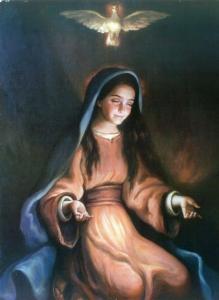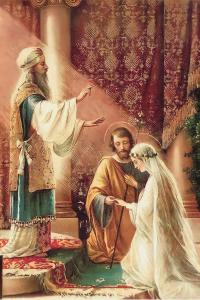
The story of Mary and Joseph is one of the most fascinating accounts in the Bible, yet it remains shrouded in mystery. From ancient vows spoken in a humble village to the enduring lessons the world can glean from their journey, the timeless legacy of this couple is nothing short of extraordinary. In an era where relationships are often fleeting and the true meaning of commitment is often lost, their unwavering devotion serves as a beacon of hope.
Jewish Background
In the first century, two distinct stages contracted a Jewish marriage. The first step was to implicitly obtain the couple`s consent, then have them sign the marriage contract, and the bride would then receive the wedding ring. Kiddushin, as it is known in Hebrew, is more than just a promise to marry, which is made through a betrothal or an engagement. According to Mosaic Law, if a woman`s fiancé were to pass away, she would be seen as a widow, and she would have to go through the process of an actual divorce in order to dissolve the bond created by kiddushin. Therefore, kiddushin fundamentally constitutes the institute of marriage.

Once kiddushin had taken place, the couple would continue to living apart in order to prepare themselves for their new life together. At times, it would give the husband enough time to save money to pay bride-dowry – sometimes it gave the young bride a chance to become a bit more mature. In some instances, the preparation period would last for a year; however, it is believed that it would take three months. When everything was in place, the husband would officially proceed to his bride`s home and the official procession to his house would follow.
The second step after kiddushin would be for the couple to be intimate (consummation) – which would be followed by a huge celebration similar to the Marriage Feast at Cana (John 2: 1-11). In the Parable of the Ten Virgins (Matthew 25: 1-13), the virgins are waiting for the husband-to-be to arrive at his bride’s home, the waiting is followed by a procession with lights to his house. Therefore, the feast of the Holy Spouses is the celebration of Mary and Joseph’s actual wedding anniversary – it is the celebration of their kiddushin. Catholic teachings make use of the terms “spouses” and “espousal” when referring to Mary and Joseph and their union because traditionally the terms “husband/wife” and “wedding” referred to a lawful marriage that was unconsummated.
When Mary agreed to become the Mother of God, she and Joseph were officially married; therefore, Jesus is legitimately a part of the Holy Family, with all the fulfilled prophecies attached thereto. However, since Jesus was conceived while Mary and Joseph were living apart and not having been intimate (Matthew 1:18), the prophecy of the Immaculate Conception in Isaiah 7:14 (“A virgin shall conceive”) is came true. As Pope Leo XIII once said, “Whereas Adam and Eve were the source of evil which was unleashed on the world, Joseph and Mary are the summits from which holiness spreads all over the earth.”
Courtship of the Holy Couple

After Mary’s parents, Anne and Joachim presented her in the Temple in Jerusalem at the age of three; they left her to live at the temple as a temple virgin devoted to serving God. When Mary was approaching womanhood (upon turning twelve, a Jewish girl would be considered to be of age), Simeon, the high priest pronounced that the time had come for all of the temple virgins who were of age to return to their parents’ homes in order for their marriages to be arranged. However, Mary told the high priest that she could not go back home because she had been dedicated by her parents to serve God and that she had vowed virginity to God.

When Simeon asked for guidance from the Lord, all unmarried men from the House of David were called forth by a loud voice; they were instructed to bring a branch to the Temple and lay it on the altar. The voice announced that flowers would blossom from the branches and that a dove, representing the Holy Spirit would rest on the branch. Joseph was among the men of the House of David and he too had put his branch on the Temple`s altar – his branched blossomed immediately into flowers and a dove from Heaven came down and rested on it, thus appointing Joseph as the Virgin Mary`s spouse.
The courtship of the Holy couple is written in two non-canonical gospels, namely the Gospel of Pseudo-Matthew and the Protoevangelium of James. In both gospels, the dove glides over Joseph’s branch, showing that he is Mary’s chosen spouse. Over the years, St. Joseph has been portrayed in paintings and statues holding a branch with budded flowers.
Not much is known about the life of Nazareth’s Holy Family, nor does Scripture give any account of how Mary and Joseph meet. The feast of The Presentation of the Blessed Virgin Mary, which is observed on November 21 to commemorate the Virgin Mary`s presentation by her parents, Saints Anne and Joachim in the Holy Temple when she was three years old – she lived in the Temple until she turned fourteen. It is believed that during her stay at the temple, Mary vowed virginity for herself, something that was rare among Jewish maidens, especially during a period when childlessness was seen as a curse. The Virgin Mary`s response to Archangel Gabriel indirectly substantiates the existence of the vow of virginity.
These reflections indicate that the espousal of Mary and Joseph is an occasion that carries deep significance. When St Bernardine of Siena describes the perfect marriage he says:
“Mary and Joseph were but one heart and soul; they were two in one same mind, one same affection, and each of them was the other’s second half, because Our Lady and he were so to speak, only one person. The heart of Mary with that of Joseph, and the heart of Joseph with that of Mary, who ever could imagine a union so intimate, a grace so great!”

The observation of the actual union of Mary and Joseph helps people to comprehend the grace of the Sacrament of Marriage. In Redemptoris Custos, St John Paul II writes, “at the culmination of the history of salvation, when God reveals his love for humanity through the gift of the Word, it is precisely the marriage of Mary and Joseph that brings to realization in full “freedom” the “spousal gift of self” in receiving and expressing such a love.” St John Paul II went on to recall the words of his predecessor, St Pope Paul VI’s, “whereas Adam and Eve were the source of evil which was unleashed on the world, Joseph and Mary are the summit from which holiness spreads all over the earth. The Savior began the work of salvation by this virginal and holy union.”
January 23
The espousal begins a yearlong contemplation on the Holy Family`s early life – the feast of The Espousal of Mary and Joseph (January 23) take place almost two months prior to the Annunciation (March 25). If the kiddushin had happened then, and presuming a three-month gap between the two marriage stages, Mary would have conceived by the power of the Holy Spirit about a month prior to the wedding procession to her spouse’s (Joseph) home.

The Annunciation rearranged the sequence of events and their espousal would not have carried a deeper meaning as it does now. According to Luke 1:39 and Luke 1:56,
Mary hurried to Judea to assist her elderly cousin, Elizabeth and she would only return after the natal of Saint John the Baptist (and probably after his circumcision as well). When Joseph saw Mary after returning from Judea, he could see that she was pregnant. Thankfully, Archangel Gabriel resolved Joseph’s confusion (Matthew 1:20-25), at which point he (Joseph) immediately “took unto him his wife” (Matthew 1:24), that is, the two started living together. A few months after that, Jesus was born, according to the liturgical calendar on December 25.

Mary and Joseph liturgically lived through the expectation of the Savior (Advent), His natal (Christmas), and His circumcision (Christmas Octave), the flight into Egypt, the massacre of infants in Bethlehem (Holy Innocents), and the visit of the Magi (Epiphany). The couple and their son also led a hidden life in Nazareth (Feast of the Holy Family). The Blessed Virgin Mary and Saint Joseph were more than just bride and groom; they were the incarnation of love.
The story of Mary and Joseph’s espousal is beautifully depicted in the Bible, providing us with a glimpse into the depth of their love and the strength of their faith. In the Gospel of Matthew, we learn that Joseph, a righteous man, discovered that Mary was pregnant before they had come together as husband and wife. Initially devastated and contemplating a quiet divorce, an angel appeared to Joseph in a dream, reassuring him of Mary’s purity and the divine nature of the child she carried. Joseph’s unwavering trust in God’s plan and his willingness to embrace his role as the earthly father of Jesus exemplify the power of faith and selflessness. Despite the social stigma and personal sacrifices he would endure, Joseph chose to honor his commitment to Mary and to God, remaining by her side throughout their journey.
Mary also displayed remarkable strength and unwavering faith during this time. Despite the potential consequences she faced as an unwed mother, Mary trusted in God’s plan and willingly accepted the role she was destined to play in the birth of the Messiah. Her obedience and willingness to submit to God’s will serve as an inspiration to countless generations, reminding us of the importance of humility and surrender in our own lives.













